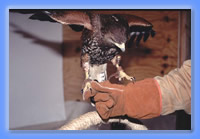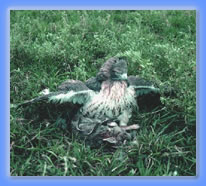Though much of the equipment has been moderized, the basic method of training a hawk for falconry has not changed since the early days. The general philosophy is to condition the hawk to accept the falconer as a partner in the hunting process while maintaining its natural physical condition and hunting instincts. Training is accomplished through careful weight management, positive reinforcement, and repetition.
The first step in training entails a period known as “manning”. It is during this time that the hawk begins to overcome its fear of people, becomes accustomed to the falconer, and learns to associate food with the falconer’s glove.
During the first few days of manning, the falconer spends many hours with the hawk. Once the hawk overcomes its initial fear of the falconer it begins to accept food rewards that are placed on the falconer’s glove. Once this occurs, the hawk is encouraged to step up onto the glove for food rewards. As the training progresses, the hawk will be encouraged to hop, jump, and eventuallly fly increasingly greater distances to the falconer. In just a couple weeks the hawk is flying to the falconer on a light line called a creance. At this stage the hawk is introduced to a lure that is garnished with food. The lure has some resemblence to the intended game the hawk will eventually hunt with the falconer. The hawk learns that whenever it comes to this lure it will receive a significant food reward.
After roughly 3 to 4 weeks of training the hawk is ready to fly completely free to pursue wild game with the falconer. This process of initially releasing a hawk to hunt a certain type of quarry is called entering. For many falconers this is the most trying time as it is at this stage that the hawk is most likely to fly away and revert to the wild. It is for this reason that it is important to release the hawk at a site where game is plentiful and the hunting instincts of the bird will prevail. If all goes well, the falconer and possibly his hunting dog will flush game that the hawk can chase, kill, and begin to eat.
Once the hawk has eaten its fill, the falconer approaches and coaxes the hawk up onto the glove with a food reward. When this occurs the hawk associates the event and the meal with the presence of the falconer. This sets the stage for the hawk to repeat the same behavior on the next hunt. The bond between the hawk and the falconer increases with continued hunting and time together. Forging this relationship with a wild raptor is what falconry is all about.
Falconry represents a unique relationship between a human and a wild animal. The falconer’s commitment to the hawk is deep. He (or she) must serve the hawk’s every need in terms of providing food, shelter, exercise, chances to hunt, and health care. The free-flying hawk has many opportunities to simply fly away and return to the wild. However, in most cases the hawk recognizes its bond to its human partner and voluntarily returns time after time to the falconer’s glove and the care he provides.



